
Turkish Air Force RF-4E Phantom II Shot Down in Syria

Turkish Air Force RF-4E Phantom II shot down because Syrian soldiers may have confused it for an Israeli plane Syrian Information Minister says.
Although much of what has happened on Jun. 22, when a Turkish Air Force RF-4E from Erhac was shot down by a Syrian air defense battery remains a mystery, at least the reasons why the aircraft was fired at after violating the Syrian airspace were (possibly) disclosed on Jun. 27, when the Syrian Information Minister Omran al-Zubi.
Indeed, as reported by the Times of Israel, the minister told the Turkish news station A Haber, that Syrian personnel operating the anti-aircraft site may have confused the Turkish RF-4E for an Israeli Phantom, even if the Israeli Air Force has decommissioned the last F-4 in 2004.
“Turkish planes and Israeli planes look alike [...] If an Israeli plane enters Syria, it is welcomed by fire. [The Turkish plane] might have been believed to be an Israeli plane; we did not want to take down a Turkish plane,” he said.
However, according to the information made public by the Turkish authorities, based on intercepted radio comms, the aircraft was clearly identified as Turkish before being downed (outside the Syrian airspace, according to Ankara’s version)
Whereas the Turkish and Syrian reconstructions of the mishap are still conflicting, Syria had previously claimed the downing of the Turkish jet (possibly involved in a mission aimed at probing Damascus air defenses near the Syrian territorial waters) was an accident caused by the “automatic response” of the officer commanding the anti-aircraft position near Lattakia.
Furthermore, the aircraft might have been downed by a new Iranian-made anti-aircraft gun whose presence was not known to the Turkish aircrew according to several Syrian news outlets.
As reported by Ynet News, Damascus purchased the new system, that can be mounted on armored vehicles and can engage planes at very low altitudes, two years ago.

Turkish Phantom shot down by Syria saga continues as new details about the mysterious shooting emerge (June 26, 2012)
On Jun. 26, NATO held a meeting of its 28 members at the request of Turkey under article 4 of the Washington treaty following the downing of the Turkish Air Force RF-4E Phantom by a Syrian Air Defense battery on Jun.22.
After the meeting NATO released the following statement:
The North Atlantic Council has met at Turkey’s request to hold consultations within the framework of Article 4 of the Washington Treaty which states that “the Parties will consult whenever, in the opinion of any of them, the territorial integrity, political independence, or security of any of the Parties is threatened.”
"The North Atlantic Council discussed the shooting down of a Turkish aircraft by Syria. We consider this act to be unacceptable and condemn it in the strongest terms. It is another example of the Syrian authorities’ disregard for international norms, peace and security, and human life.
Our thoughts at this difficult time are with the missing Turkish aircrew, their families and their loved ones. We continue to follow the situation closely and with great concern, and will remain seized of developments on the South-Eastern border of NATO.
The security of the Alliance is indivisible. We stand together with Turkey in the spirit of strong solidarity."
The New York Times ran an article (later picked up elsewhere) that included a scan of a letter sent from Turkey to the UN.
The letter includes several details that provide a clear view of the Turkish version of the episode.
Firstly the exact position of where the Phantom was hit: 35 48.22N – 35 32.21E which is 13NM from the coast of Syria and therefore in international airspace. This means the aircraft had violated the Syrian airspace but, according to the Turkish authorities, it had already left it when it was shot down at 11.58 local time.
Secondly according to the text of the letter, was flying at 7,400 feet on its own (not part of a pair) and after being hit turned towards the Syrian coast and hit the sea at 35 48.26N – 35 37.59E some 8NM from the coast.
Again the letter states the plane was transmitting its IFF (indentification, friend or foe) transponder and that Turkey has captured radio communications that demonstrates Syrian units knew this was a Turkish plane. The letter also alluded that Turkey may have proof from third party radar stations that could have recorded the route flown by the combat plane.
Noteworthy, the letter does not say that the RF-4ETM (this is the correct designation) was downed by a missile. However, if it was really flying so far from the coast (13 NM) and at medium altitude (7,400 ft), it could not be reached by anti-aircraft artillery flak.
Moreover, the letter confirmed that a search and rescue asset was fired upon whilst searching for the downed aircrew: it was a CASA (thought to be a CN-235) aircraft targeted by anti-aircraft artillery positioned on the Syrian shore.
Letter aside, new details about the mysterious Turkish activity near the Syrian territorial waters have emerged.
As said the aircraft was flying a preplanned route which included several similar patterns (this being one of the few things both parties agree on).
According to the data released by Turkey here’s how the airspace violation developed:
11.42LT: the aircraft “unintentionally” entered the Syrian airspace at 200 feet with a North East heading
11.44LT: a Turkish radar station (most probably the one providing assistance to the flight) issued an airspace violation warning
11.47LT: after turning left (and coming extremely close to the Syrian coast) the RF-4E exited the Syrian airspace
11.50LT: the pilot contacted the Turkish radar to inform it that they would have performed the same profile and asking for positive radar control not to repeat airspace violation.
11.58LT: the Phantom was hit while it was repositioning for a second pattern
Although it is extremely weird that the Syrian air defense shot down the Phantom 15 minutes after it violated the Syrian airspace (according to the Turkish version), it is at least as suspect that a combat plane flying under positive radio and radar contact, possibly under radar control or advisory service, violates a foreign airspace without being warned by its own air traffic control agency well before the violation occurs.
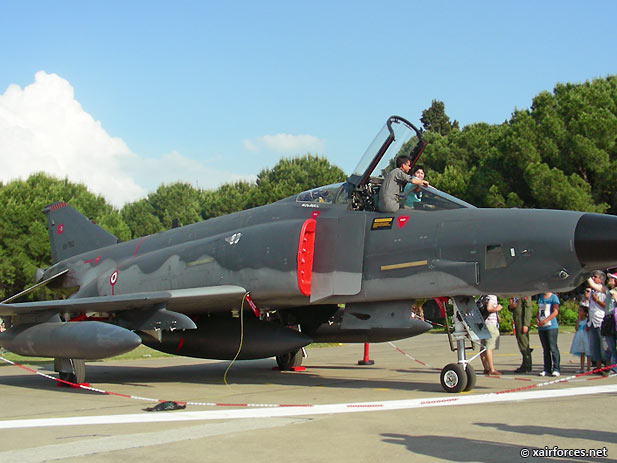
Turkish Phantom shot down in Syria update: it may have violated the Syrian airspace to probe the air defenses readiness (June 25, 2012)
According to the latest news about the Turkish F-4 shot down by a Syrian Air Defense battery on Jun. 22, the North Atlantic Council will meet on Tuesday Jun. 26, following a request by Turkey under article 4 of NATO’s founding Treaty.
Under article 4 of the Treaty, any ally can request consultation whenever, in the opinion of any of them, their territorial integrity, political independence or security is threatened.
The problem is that Turkey says the unarmed combat plane (173Filo/7Aju) from Erhac, shot down by the Syrian military was engaged without warning.
The aircraft was testing a domestic radar system and was fired at upon leaving Syrian airspace, Turkish Foreign Minister Ahmet Davutoglu said. He also confirmed that the aircraft did enter Syrian airspace before being engaged by the Syrian Anti-Aircraft Artillery, although it had happened by mistake.
As explained on several posts of the Airspace Violations series, aircraft violating a foreign airspace should not be fired upon but warned, intercepted and eventually escorted outside the violated airspace. Anyway, what is still far from being explained is the reason why an (R)F-4 was flying at low level and high-speed just 1 km off the Syrian coast. There are at least three possibilities: navigation error, weather, or intentional violation to probe the enemy air defense readiness.
Although the navigation error can’t never be ruled out a priori, considering the equipment carried by the aircraft, the fact that there are two crew members in a Phantom and, above all, that the plane was flying next to a “danger zone” there’s reason to believe that the two on board were perfectly aware of their position.
What is particularly interesting is the altitude at which the plane was flying when it entered the Syrian airspace. It was extremely low (and it was most probably gunned optically, with no radar lock). As a NATO pilot told me “when you are flying at hi-speed low-altitude you are either performing a rather awkward attempt to penetrate the enemy airspace to use the onboard sensors or to keep below the cloud cover. However, since flying an ISR (Intelligence Surveillance Reconnaissance) mission at low level and less than 12 nautical miles from the coast is almost useless, I think they were probing the Syrian air defense. And I think that they now have a good idea of their readiness status that is, among the others, one of the most interesting things we can learn from the incident.”
Although they most probably knew that the aircraft was a Turkish Air Force plane, the Syrians may have mistaken it for a defecting Syrian Arab Air Force plane. Hence they shot it down before it could reach Turkey, to prevent another embarrassing episode like the one of the Mig-21 that defected to Jordan.
Even if one might believe that buzzing the enemy airspace to test its reaction time or actively disturbing the enemy training activities is something rare, it is not for Turkey or Syria according to what the NATO pilot told to The Aviationist:
“Few years ago, I was flying as a backseater of a Turkish combat plane during a Taceval at Diyarbakir. Our route brought us along the border with Syria and for almost all that leg of our flight our radio communication were (actively) disturbed. Since the jamming of the radio communications was not planned for that kind of mission, it was most probably the effect of a direct action of the Syrian armed forces.”
In the meantime, the fuselage and ejection seats were located (meaning that both pilots have ejected) but they were not recovered yet.
Their names were made public as Captain Gökhan Ertan and Lieutenant Hasan Hüseyin Aksoy.
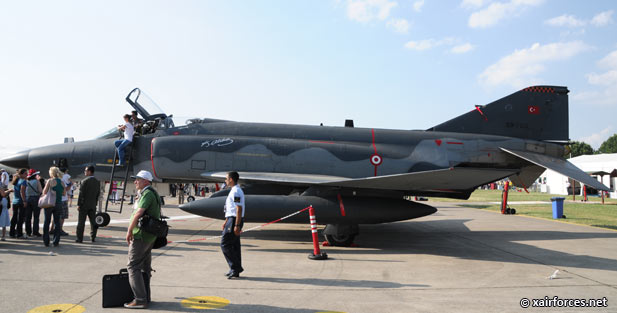
Turkish Phantom shot down by Syria update: Damascus releases the route flown by the plane (June 23, 2012)
On Jun. 23 Syrian news agency SANA has published the following statement issued by a Syrian military spokesman, which provides the version of Damascus about the mysterious downing of a Turkish F-4 Phantom off the Syrian coast on Jun. 22.
At 11:40 AM on 22/6/2012, an unidentified aerial target violated Syrian airspace, coming from the west at a very low altitude and at high speed over territorial waters, so the Syrian anti-air defenses counteracted with anti-aircraft artillery, hitting it directly as it was 1 kilometer away from land, causing it to crash into Syrian territorial waters west of Om al-Tuyour village in Lattakia province, 10 kilometers from the beach.
Noteworthy, an image showing the actual route flown by the downed aircraft was released.
This is much interesting because, if genuine, it shows that the F-4 was circling off the Syrian coast before it headed towards the coast at low altitude and it was downed by the Anti-Aircraft Artillery fire.
As suggested by some readers, the RF-4E was probably carrying an Elbit’s LOROP reconnaissance system that gives the aircraft the ability to gather hi-rez imagery in both visible and IR spectrums at ranges up to 100 km from the target.
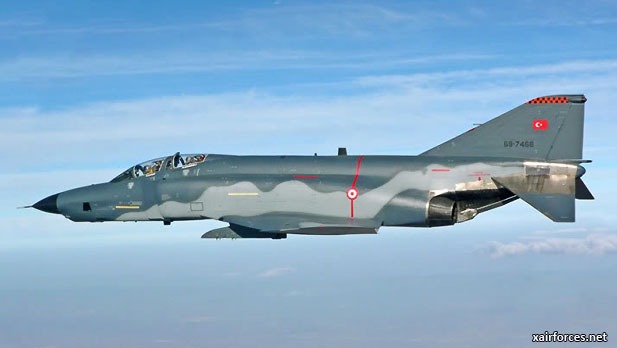
Turkish RF-4E Phantom shot down by Syrian Air Defense battery. Known and unknown facts. (June 22, 2012)
Late on the afternoon (Central European Time) of Jun. 22, media outlets started to report that a Turkish Air Force F-4 Phantom has disappeared over the Eastern Mediterranean Sea, near its shared border with Syria.
The Phantom had left Erhac Air Base at around 07.30GMT and disappeared off radar around 09.00 GMT.
Reports came out of Turkey soon after saying that Turkish prime minister Recep Tayyip Erodgan had claimed that Syria had apologised for shooting down the jet, however at a press conference he told the gathered reporters that he could not confirm reports that Syria had shot down the jet and had apologised.
Later, Erdogan confirmed that the plane was shot down, that the crew fate is still uncertain and that Turkey will take all necessary measures ‘decisively’ once all details of incident emerge.
The early reports stated that the F-4 had disappeared off radar screen flying over international waters but had crashed into waters that were in Syrian territory near to the town of Latakia, prompting Turkish authorities to request permission to send their forces into the area to search for the two missing pilots. The press association are quoting Hebollah’s Manar TV as saying Syrian air defences had shot the jet down citing unnamed Syrian security sources.
Latest reports say that both Turkish and Syrian gunboats are searching the sea in the area where the jet is thought to have come down but the news on the pilots is conflicting: some saying they have been picked up, others stating they are still missing.
Turkish Prime Minister Erodgan has called an emergency security meeting and will be attended by top military and intelligence officials.
Turkey is part of NATO and could in theory invoke Article V of the North Atlantic Treaty where all of the 28 member countries should come to the aid of a member under attack.
All of the above paints a very confusing picture of events over the eastern Mediterranean Sea on the day after a Syrian Mig-21 defected to Jordan.
First of all, it’s still unclear which type of aircraft was downed (or simply crashed) and what kind of mission the aircraft was flying when it was downed: the Turkish Air Force operates a mixed fleet of F-4E-2020 Terminator, RF-4E/TM Isik upgraded Recce Phantoms, and F-4E/TM Simsek. Although it has yet to be confirmed, the aircraft (flying with another F-4 of the same type) was probably a Recce Phantom on an ISR (Intelligence Surveillance Reconnaissance) mission.
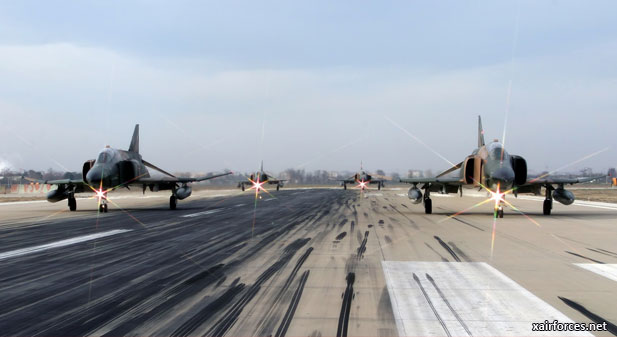
In simple words: it was spying on Assad forces in the North of Syria.
Then, if it was really shot down by a Syrian SAM (Surface to Air Missile) battery, which kind of missile hit the Phantom?
According to rumors, it was an SA-5 Gammon (S-200) a long range medium to high-altitude mobile SAM produced by the Soviets in the ’60s. Five SA-5 sites are known to be active in Syria.
The (aging) system (very well known to NATO in terms of capability, range, operating radio frequencies, signature, etc.) uses radio semi active guidance with terminal active radar homing. With a peak speed of around Mach 8 a single-shot kill probability is quoted as 0.85, presumably against a high altitude heavy bomber-type of target, should be less against a fast maneuvering combat plane.
Therefore, connecting the dots, the RF-4 was most probably flying outside the Syrian airspace at high altitude on a recce mission (still, there’s a residual chance it was a flight of F-4Es on a mission aimed at testing the Syrian air defense readiness). It was downed by an SA-5 shot that proved that this kind of missile can be lethal even if fired by accident by personnel believed to be not so very well trained (this being a serious issue should NATO eventually decide to establish a No-Fly Zone over Syria).
Update Jun. 22, 2012 22.46 GMT
According to the spokesman of the Syrian Ministry of Foreign Affairs, the aircraft was gunned down by anti-aircraft fire as the aircraft was flying 1 km off the coast of Syria.
A video allegedly showing the air defense battery firing at the Phantom (and bringing it down with a very short burst..) was posted on Youtube..
If this video is genuine (no aircraft can be spotted), the scenario changes a lot: the F-4 was flying well inside the Syrian air space at low/medium altitude when the Syrian Air Defense (most probably on a heightened alert status to prevent any other defection) shot it down.
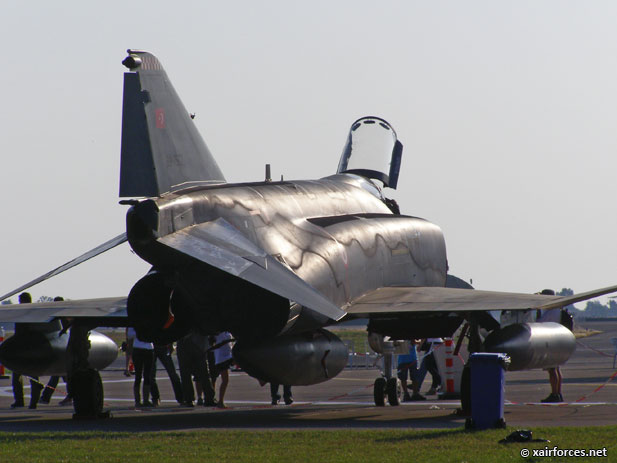
Source: By The Aviationist’s Editor David Cenciotti, 28 June 2012 - theaviationist.com News
Photo: Turkish Air Force RF-4E Phantom II Shot Down in Syria (Photos by © XairForces.net and TUAF)
(28.06.2012)
|